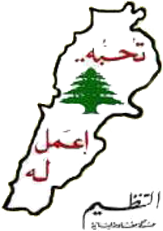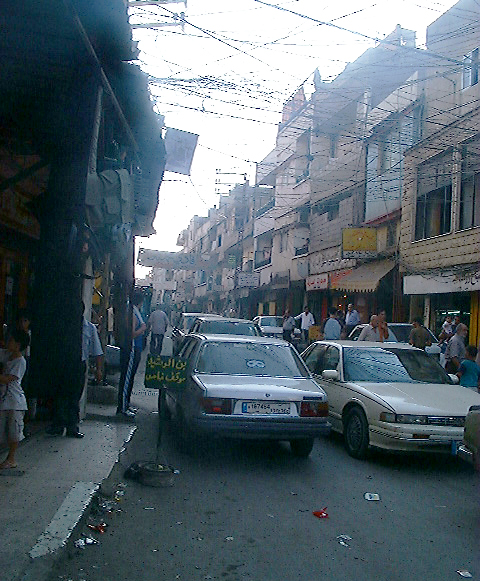|
Al-Ghuraba Cemetery
Al-Ghuraba cemetery is a cemetery in Tripoli, Lebanon. It has been used in the past for mass burials relating to the Lebanese Civil War and the 2007 Lebanon conflict. Since the 1970s the cemetery has been occupied by a number of makeshift homes and, in 2010, had a population of 1,000 people. In 2015 the housing condition was reported to be poor by Care International. Burials Al-Ghuraba cemetery is located near to the Bab-al-Tibbaneh and Jabal Mohsen neighbourhoods of Tripoli. The name means "strangers" in Lebanese Arabic. The cemetery has been used for mass burials of those killed in conflict. Amnesty International reported in 1989 that up to 200 men, women and children who were killed in Bab-al-Tibbaneh on 21 and 22 December 1986 may have been buried in a mass grave in the cemetery, excavated by bulldozer. Some of those killed were civilians caught in a crossfire during the Lebanese Civil War but others are alleged to have been Sunni Muslims summarily executed by Syrian ... [...More Info...] [...Related Items...] OR: [Wikipedia] [Google] [Baidu] |
Lebanon
Lebanon ( , ar, لُبْنَان, translit=lubnān, ), officially the Republic of Lebanon () or the Lebanese Republic, is a country in Western Asia. It is located between Syria to Lebanon–Syria border, the north and east and Israel to Blue Line (Lebanon), the south, while Cyprus lies to its west across the Mediterranean Sea; its location at the crossroads of the Mediterranean Basin and the Arabs, Arabian hinterland has contributed to History of Lebanon, its rich history and shaped Culture of Lebanon, a cultural identity of demographics of Lebanon#Religious groups, religious diversity. It is part of the Levant region of the Middle East. Lebanon is home to roughly six million people and covers an area of , making it the List of countries and dependencies by area, second smallest country in continental Asia. The official language of the state is Arabic, while French language, French is also formally recognized; the Lebanese Arabic, Lebanese dialect of Arabic is used alongside Mo ... [...More Info...] [...Related Items...] OR: [Wikipedia] [Google] [Baidu] |
Tripoli, Lebanon
Tripoli ( ar, طرابلس/ALA-LC: ''Ṭarābulus'', Lebanese Arabic: ''Ṭrablus'') is the largest city in northern Lebanon and the second-largest city in the country. Situated north of the capital Beirut, it is the capital of the North Governorate and the Tripoli District, Lebanon, Tripoli District. Tripoli overlooks the eastern Mediterranean Sea, and it is the northernmost seaport in Lebanon. It holds a string of four small islands offshore. The Palm Islands Nature Reserve, Palm Islands were declared a protected area because of their status of haven for endangered loggerhead turtles (''Chelona mydas''), rare monk seals and migratory birds. Tripoli borders the city of El Mina, the port of the Tripoli District, which it is geographically conjoined with to form the greater Tripoli conurbation. The history of Tripoli dates back at least to the 14th century BCE. The city is well known for containing the Mansouri Great Mosque and the largest Crusader States, Crusader fortress in L ... [...More Info...] [...Related Items...] OR: [Wikipedia] [Google] [Baidu] |
Lebanese Civil War
The Lebanese Civil War ( ar, الحرب الأهلية اللبنانية, translit=Al-Ḥarb al-Ahliyyah al-Libnāniyyah) was a multifaceted armed conflict that took place from 1975 to 1990. It resulted in an estimated 120,000 fatalities and an exodus of almost one million people from Lebanon. The diversity of the Lebanese people, Lebanese population played a notable role in the lead-up to and during the conflict: Lebanese Sunni Muslims, Sunni Muslims and Christianity in Lebanon, Christians comprised the majority in the coastal cities; Shia Islam, Shia Muslims were primarily based in Southern Lebanon, the south and the Beqaa Valley in the east; and Lebanese Druze, Druze and Christians populated the country's mountainous areas. The Lebanese government had been run under the significant influence of elites within the Lebanese Maronite Christians, Maronite Christian community. The link between politics and religion had been reinforced under the Mandate for Syria and Lebanon, F ... [...More Info...] [...Related Items...] OR: [Wikipedia] [Google] [Baidu] |
2007 Lebanon Conflict
The 2007 Lebanon conflict began when fighting broke out between Fatah al-Islam, an Islamist militant organization, and the Lebanese Armed Forces (LAF) on May 20, 2007 in Nahr al-Bared, an UNRWA Palestinian refugee camp near Tripoli. It was the most severe internal fighting since Lebanon's 1975–90 civil war. The conflict revolved mostly around the siege of Nahr el-Bared, in addition to clashes that occurred in the Ain al-Hilweh refugee camp in southern Lebanon and other bombings that took place in and around the Lebanese capital, Beirut. Fighting ended in September 2007. Background Nahr al-Bared refugee camp Lebanon hosts more than 400,000 Palestinian refugees, some 215,000 of whom live in camps, including the descendants of those who fled from Palestine during the 1948 Arab-Israeli War. In 1962, Palestinians were categorized as foreigners in Lebanon, regardless of how long they had lived there. Non-Lebanese, which included the refugees, were restricted from working in ... [...More Info...] [...Related Items...] OR: [Wikipedia] [Google] [Baidu] |
Care International
CARE (Cooperative for Assistance and Relief Everywhere, formerly Cooperative for American Remittances to Europe) is a major international humanitarian agency delivering emergency relief and long-term international development projects. Founded in 1945, CARE is nonsectarian, impartial, and non-governmental. It is one of the largest and oldest humanitarian aid organizations focused on fighting global poverty. In 2019, CARE reported working in 104 countries, supporting 1,349 poverty-fighting projects and humanitarian aid projects, and reaching over 92.3 million people directly and 433.3 million people indirectly. CARE's programmes in the developing world address a broad range of topics including emergency response, food security, water and sanitation, economic development, climate change, agriculture, education, and health. CARE also advocates at the local, national, and international levels for policy change and the rights of poor people. Within each of these areas, CARE focuses ... [...More Info...] [...Related Items...] OR: [Wikipedia] [Google] [Baidu] |
Lebanese Arabic
Lebanese Arabic ( ar, عَرَبِيّ لُبْنَانِيّ ; autonym: ), or simply Lebanese ( ar, لُبْنَانِيّ ; autonym: ), is a variety of North Levantine Arabic, indigenous to and spoken primarily in Lebanon, with significant linguistic influences borrowed from other Middle Eastern and European languages and is in some ways unique from other varieties of Arabic. Due to multilingualism and pervasive diglossia among Lebanese people (a majority of the Lebanese people are bilingual or trilingual), it is not uncommon for Lebanese people to code-switch between or mix Lebanese Arabic, English, and French in their daily speech. It is also spoken among the Lebanese diaspora. Lebanese Arabic is a descendant of the Arabic dialects introduced to the Levant in the 7th century AD, which gradually supplanted various indigenous Northwest Semitic languages to become the regional lingua franca. As a result of this prolonged process of language shift, Lebanese Arabic possesses a ... [...More Info...] [...Related Items...] OR: [Wikipedia] [Google] [Baidu] |
Amnesty International
Amnesty International (also referred to as Amnesty or AI) is an international non-governmental organization focused on human rights, with its headquarters in the United Kingdom. The organization says it has more than ten million members and supporters around the world. The stated mission of the organization is to campaign for "a world in which every person enjoys all of the human rights enshrined in the Universal Declaration of Human Rights and other international human rights instruments." The organization has played a notable role on human rights issues due to its frequent citation in media and by world leaders. AI was founded in London in 1961 by the lawyer Peter Benenson. Its original focus was prisoners of conscience, with its remit widening in the 1970s, under the leadership of Seán MacBride and Martin Ennals to include miscarriages of justice and torture. In 1977, it was awarded the Nobel Peace Prize. In the 1980s, its secretary general was Thomas Hammarber ... [...More Info...] [...Related Items...] OR: [Wikipedia] [Google] [Baidu] |
Mass Grave
A mass grave is a grave containing multiple human corpses, which may or may Unidentified decedent, not be identified prior to burial. The United Nations has defined a criminal mass grave as a burial site containing three or more victims of execution, although an exact definition is not unanimously agreed upon. Mass graves are usually created after many people die or are killed, and there is a desire to bury the corpses quickly for sanitation concerns. Although mass graves can be used during major conflicts such as war and crime, in modern times they may be used after a famine, epidemic, or natural disaster. In disasters, mass graves are used for infection and disease control. In such cases, there is often a breakdown of the social infrastructure that would enable proper identification and disposal of individual bodies. History Mass or communal burial was a common practice before the development of a dependable crematory chamber by Ludovico Brunetti in 1873. In ancient Rome waste a ... [...More Info...] [...Related Items...] OR: [Wikipedia] [Google] [Baidu] |
Sunni Muslim
Sunni Islam () is the largest branch of Islam, followed by 85–90% of the world's Muslims. Its name comes from the word ''Sunnah'', referring to the tradition of Muhammad. The differences between Sunni and Shia Muslims arose from a disagreement over the succession to Muhammad and subsequently acquired broader political significance, as well as theological and juridical dimensions. According to Sunni traditions, Muhammad left no successor and the participants of the Saqifah event appointed Abu Bakr as the next-in-line (the first caliph). This contrasts with the Shia view, which holds that Muhammad appointed his son-in-law and cousin Ali ibn Abi Talib as his successor. The adherents of Sunni Islam are referred to in Arabic as ("the people of the Sunnah and the community") or for short. In English, its doctrines and practices are sometimes called ''Sunnism'', while adherents are known as Sunni Muslims, Sunnis, Sunnites and Ahlus Sunnah. Sunni Islam is sometimes referred ... [...More Info...] [...Related Items...] OR: [Wikipedia] [Google] [Baidu] |
Fatah Al-Islam
Fatah al-Islam ( ar, فتح الإسلام, meaning: ''Conquest of Islam'') is a radical Sunni Islamist group that formed in November 2006 in a Palestinian refugee camp, located in Lebanon. It has been described as a militant jihadistLe Figaro (16 April 2007)"Fatah Al-Islam: the new terrorist threat hanging over Lebanon". Retrieved 20 May 2007. movement that draws inspiration from al-Qaeda.Reuters (19 May 2007)"Lebanese army battles militants at Palestinian camp" Retrieved 20 May 2007. It became well known in 2007 after engaging in combat against the Lebanese Army in the Nahr al-Bared UNRWA Palestinian refugee camp. Following its defeat at Nahr el-Bared, the group relocated to the Ain al-Hilweh refugee camp near Sidon in 2008. As of 2014, after the death or capture of many members, most of the surviving members of Fatah al-Islam are thought to have joined other groups in Lebanon and Syria including the Free Syrian Army, Al-Nusra Front, Ahrar al-Sham, and the Islamic State o ... [...More Info...] [...Related Items...] OR: [Wikipedia] [Google] [Baidu] |
Mortmain
Mortmain () is the perpetual, inalienable ownership of real estate by a corporation or legal institution; the term is usually used in the context of its prohibition. Historically, the land owner usually would be the religious office of a church; today, insofar as mortmain prohibitions against perpetual ownership still exist, it refers most often to modern companies and charitable trusts. The term ''mortmain'' is derived from Mediaeval Latin ''mortua manus'', literally "dead hand", through Old French ''morte main'' (in modern French, ''mainmorte''). History During the Middle Ages in Western European countries such as England, the Roman Catholic Church acquired a substantial amount of real estate. As the Church and religious orders were each recognised as a legal person separate from the office holder who administered the Church land (such as the abbot or the bishop), the land would not escheat on the death of the holder, or pass by inheritance, as the Church and the religious ... [...More Info...] [...Related Items...] OR: [Wikipedia] [Google] [Baidu] |






